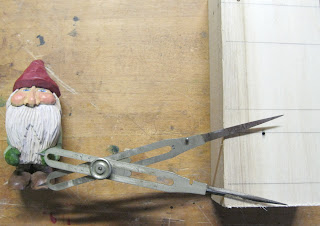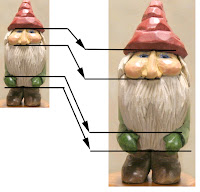 |
| My working prototype |
I like to be mobile with my carving activities. So when I came across plans for a carver's lapboard on the WCI web site, I knew this would be perfect for me. With my woodworking background I knew I could make it even better for my own use. I used the WCI plan as my starting point and added a few things. The front lip was the first area I focused on. Instead of the little blocks cut on angle to form the inside radius, I opted to use a thin, bendable strip. Lighter, easier to produce and, well, just better looking. Second, I didn't like the trays for tools. I want my tools kept away from my hands and each other when they are not in use. I have seen PVC used for this purpose so I went with that. I wanted each tool to be the same distance from me, so I decided to round the back and the tool ledge. I consider my lap table a prototype and will most likely improve it a little each time I make another. All I can say is this thing has changed my life. I carve almost every day and to clean up my work area, I just move the whole table from wherever I'm carving to my shop.
All sizes are suggested, though the top was based on my body size. You need room for your arms on either side of the front radius. Since I have a working wood shop, finding the materials for this was a matter of diverting a few scraps headed for the trash bin. Of course, you could buy all the materials from a home center and I'm sure it won't cost much, though I haven't priced it out. I used 1/2" plywood too keep it light, but use whatever you like.
Here's what you'll need:
1 - 18" X 24" X 1/2 plywood (Home Depot sells 24" X 24" pieces pre-cut.)
1 - 6" X 18" X 1/2" plywood for the tool ledge.
18 pcs - 3/4" PVC X 3 3/4"

1 - 1 1/8" X 1/8" strip for front radius lip
2" X 1/4" strips for side and back edges
foam padding - whatever you have lying around. I used old interlocking floor mat
Electricians tape
any kind of protective finish
Procedure:

Start by cutting the deck to 18" X 24". Layout the back radius (about 17 3/4" radius). Do not cut this yet. Mark a point back from the front edge about 3". Mark either side about 5" in from the edge. At this mark, layout a 45 degree angle in toward the center. We are going to layout the actual curve according to our body size. We want this to fit right up against the belly. The picture to the right shows how this lip will look when we're done.
The next part can be done alone, but a helper would be very useful. We're relying on the wood to bend naturally to a smooth curve by putting tension on the ends. Don't make any sudden moves and the 1/8" thick strip should bend to this radius without cracking. Maple or poplar is a good choice.

With the deck on a bench in front of you, clamp two small blocks to the 45 degree lines. Hold the strip against your belly to form the radius. With an even tension, move the strip to the deck and mark the radius. Clamp the strip to one block (left one if you are a righty). Put enough tension to bend the strip to the center 3" marl and against the right hand block. With a pencil, mark both sides of the strip.
Remove the clamps and block and cut out the inside radius. This cut needs to be done very carefully and to
both lines. This space will be equal to the thickness of the front strip. The cutoff piece will help put pressure on the strip when clamping. If you make a good cut, you might only need one clamp. Add more clamps if you need them. That's why we didn't cut the back radius yet, a mistake I made on the prototype.

I cut it this way to show the gap. In reality, you will cut all of one line, then the other. You can use a sanding drum or the front cylinder of a belt sander to smooth out the inside radius so the strip fits without big gaps.
Finally we dry clamp the strip. I let it sit like this for a while so it gets use to the bend. If the fit looks good. You can go ahead and glue and re-clamp the strip. Check that the edge is even and nearly flush on the bottom.
This needs to cure over night so the edge is sure to stay in place when you take off the clamps.
Go carve something! We'll continue in Part 2.
 This will be my last post for 2010! I finished a few pieces in the past week or so, but they are for gifts to my family members, so I don't want to post them until after the holidays.
This will be my last post for 2010! I finished a few pieces in the past week or so, but they are for gifts to my family members, so I don't want to post them until after the holidays.















































